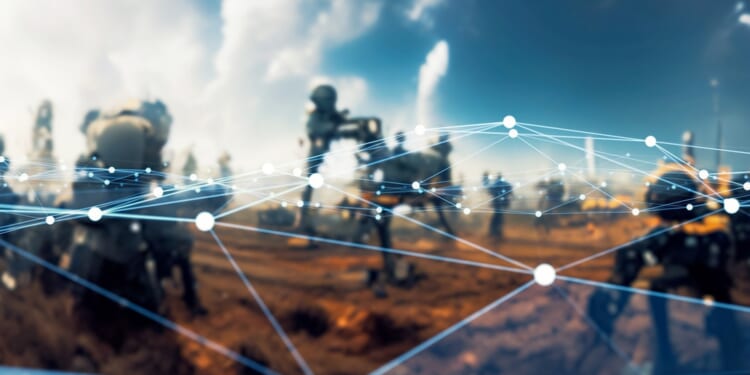As AI and autonomous warfare advance, our future mirrors a collision of Minority Report, Star Wars, The Fifth Element, and Idiocracy—demanding innovation with safeguards and clear global engagement.
We’re living in a moment where autonomous systems share headlines with deepfake scandals and viral misinformation. When I consider which science fiction future we’re headed toward, I don’t see a single vision—I see a collision. The future unfolding looks less like the clean dystopia of Blade Runner or the hopeful order of Star Trek, and more like the chaotic mashup we never expected: the sleek technological vision of Minority Report and Star Wars: Episode II – Attack of the Clones, colliding with the cultural decay of Idiocracy and the layered absurdities of The Fifth Element.
Nowhere is this paradox more apparent than in artificial intelligence (AI) and autonomous warfare—where cutting-edge machine learning systems make life-and-death decisions while society grapples with what these capabilities mean for our future.
The Minority Report Promise—AI That Sees Around Corners
Minority Report gave us PreCrime: a system that could predict and prevent violence before it happened. Today’s military AI isn’t quite there, but it represents a fundamental shift in how warfare is conducted. Autonomous systems can now process intelligence, identify threats, and—in increasingly advanced systems—support targeting decisions faster than any human could react.
This is the compelling promise: better information, processed instantly, enabling more precise action. In the film, Tom Cruise’s character wrestles with a system that’s both remarkably accurate and deeply flawed. We face similar challenges today. AI-enabled systems have demonstrated real potential to reduce civilian casualties through improved precision and intelligence analysis. They can process vast amounts of sensor data, identify patterns humans might miss, and provide decision-makers with clearer pictures of complex battlespaces.
The technology is advancing rapidly because it offers genuine advantages. The critical question isn’t whether to develop these capabilities—our strategic competitors are already racing ahead—but how to develop them responsibly. How do we harness AI’s potential while ensuring human judgment remains central to the most consequential decisions?
The Clone Wars Problem—Distance and Accountability
Star Wars: Episode II – Attack of the Clones introduced us to clone armies: manufactured soldiers that made war more palatable for democratic societies because real citizens weren’t dying. The parallels to autonomous weapons systems are worth examining, though not because automation is inherently problematic.
When systems operate with increasing autonomy—whether Turkish Kargu-2 loitering munitions, Russian and Ukrainian autonomous platforms, or China’s “intelligentized warfare” initiatives—we’re changing the calculus of conflict. The technology itself is neutral; what matters is how we employ it.
Star Wars showed us that making warfare too easy corrodes careful deliberation. But the answer isn’t to avoid the technology. Our adversaries won’t show such restraint, and falling behind in autonomous systems could prove catastrophic for national security. Instead, we need frameworks that preserve human accountability even as we leverage AI’s speed and precision.
This means designing systems with meaningful human oversight built into the core architecture, rather than adding it on after the fact. It means establishing clear rules of engagement that define when and how autonomous systems can operate. It means investing in the doctrine, training, and command structures that ensure technology enhances rather than replaces human judgment.
The Fifth Element Reality—The Global Competition
The Fifth Element gave us a future of dazzling technology existing alongside profound inequality—flying cars above, poverty below, and a vertically stratified world. The film’s New York literally separated those with access to advanced technology from those without.
This stratification is already visible in military AI. The United States, China, Russia, and a handful of other nations are making massive investments in autonomous systems, artificial intelligence, and the computational infrastructure to support them. This isn’t accidental—AI capabilities are becoming synonymous with geopolitical power projection.
The global AI arms race creates tiers of military capability. Nations with advanced AI will be able to monitor, predict, and respond with unprecedented speed and precision. Those without will find themselves at a growing disadvantage, unable to defend their sovereignty against adversaries who operate at machine speed.
This is why responsible development matters so much. If only authoritarian regimes push the boundaries of autonomous warfare, they’ll define the norms. If democracies lead in both capability and responsible use, we can shape international standards around transparency, accountability, and human control. The goal isn’t to slow down—it’s to move forward deliberately, demonstrating that advanced AI and ethical constraints aren’t contradictory.
The Idiocracy Risk—Maintaining Strategic Thinking
Mike Judge’s Idiocracy showed a future where society becomes so culturally diminished that it can no longer solve basic problems, even as technology persists around them. The plants don’t grow because everyone’s watering them with sports drinks, convinced by marketing that it’s better than water.
The warning here isn’t about intelligence—it’s about attention and rigor. Public discourse on AI warfare often oscillates between utopian hype and apocalyptic fear, with limited space for the nuanced analysis these questions demand. Meanwhile, competitors are making concrete, sustained progress.
The risk isn’t that we lack technological capability—America’s defense technology base remains the world’s most innovative. The risk is that societal attention spans have shortened while the strategic challenges have grown more complex. When public debate reduces AI warfare to soundbites, when sustained focus on critical national security questions becomes difficult—we create vulnerabilities.
This is where those of us developing these technologies have a responsibility. We need to communicate clearly about both capabilities and limitations. We need to engage seriously with ethical questions, not dismiss them as obstacles to innovation. And we need to demonstrate that advancing AI capabilities and implementing responsible safeguards aren’t competing priorities—they’re complementary ones.
The Path Forward—Responsible Innovation
So which science fiction future are we headed toward? The honest answer is: we’re deciding right now. We’re at an inflection point where the choices we make about AI warfare will shape geopolitical stability for decades.
The optimistic case—and I believe it’s achievable—is that we can harness Minority Report’s technological sophistication while avoiding its determinism. We can maintain military advantage without falling into The Clone Wars’ moral hazards. We can prevent The Fifth Element’s permanent stratification through thoughtful international engagement. And we can reject Idiocracy’s shallow thinking by demanding rigor in how we approach these questions.
This requires several things:
- Technical excellence with built-in safeguards. We need to develop AI systems that are both highly capable and inherently controllable. This means investing in explainable AI, robust testing regimes, and fail-safe mechanisms from the ground up.
- Clear doctrine and rules of engagement. Technology alone doesn’t determine outcomes—how we employ it does. We need doctrinal frameworks that specify when autonomous systems can operate, what authorities they have, and how human oversight functions.
- International engagement without naïveté. Arms control for AI weapons is extraordinarily difficult, but that doesn’t make it worthless. We should pursue international norms around transparency and constraints while maintaining the capabilities necessary for deterrence.
- Public engagement and education. The most important safeguard is an informed citizenry that understands both the necessity of these capabilities and the importance of responsible development.
The future we’re building won’t look like any single movie or book—it’ll be complex, probably contradictory, and uniquely our own. As someone working at the intersection of AI and defense, I see both the tremendous potential and the genuine risks. The technology offers real advantages: better intelligence, more precise operations, and a faster response to threats. These aren’t abstract benefits—they translate to lives saved and conflicts deterred.
But potential and outcome aren’t the same thing. We’ll only realize the optimistic future if we pursue innovation responsibly—if we push the boundaries of what’s technically possible while maintaining the ethical frameworks that define who we are.
The optimistic case for our future isn’t that technology will save us. It’s that we can be thoughtful enough, deliberate enough, and wise enough to ensure that as we advance AI capabilities, we advance our ability to control and direct them toward worthy ends.
That’s not Star Trek yet—but it’s a future worth building toward, one careful decision at a time.
About the Author: Rick Hubbard
Rick Hubbard is Chief Scientist at Core4ce and leads the Autonomy, Artificial Intelligence, and Machine Learning (AAIM) Lab.
Image: metamorworks/shutterstock


















